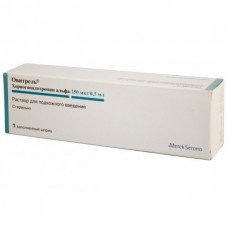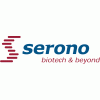Expiration date: 03/2026
Dosage form
The solution is clear or slightly opalescent, colorless or light yellow color.
Composition
1 syringe (0.5 ml)
the hCG stimulation alpha009250 micrograms (6500 IU)
Auxiliary substances: mannitol, methionine, poloxamer 188, phosphoric acid, sodium hydroxide, water d/and.
0.5 ml - colourless glass syringes (1) complete with needles d/and (1 PCs.) - plastic containers (1) - packs of cardboard.
Pharmacological action
Recombinant alpha hCG stimulation, which has the same amino acid sequence as the natural human chorionic gonadotropin. Binds transmembrane LH receptors on surface of granulosa and theca cells of the ovary. Vozianova causes the initiation of meiosis, rupture of the follicles (ovulation) and formation of the corpus luteum, production of progesterone and estradiol yellow body.
Luteinizing tool
Pharmacokinetics
When s/to the introduction of the absolute bioavailability is approximately 40%, T1/2 about 30 h.
Side effects
From the digestive system: often (>1/100, <1/10) - nausea, vomiting, abdominal pain; rare (>1/1000, <1/100) - diarrhea.
Part of the reproductive system: often (>1/100, <1/10) - ovarian hyperstimulation syndrome (ohss); rare (>1/1000, <1/100) - severe ohss, breast tenderness.
CNS: often (>1/100, <1/10) - headache; rare (>1/1000, <1/100) depression, irritability, anxiety, fatigue.
Dermatological reactions: very rare (>1/10 000) - reversible mild skin rash.
Local reactions: often (>1/100, <1/10) pain and redness at the injection site.
Other: often (>1/100, <1/10) fatigue; very rare (>1/10 000) - allergic reactions in the form of light.
Special conditions
Before treatment it is necessary to establish the causes of infertility in a female patient and her partner and to evaluate the alleged risk factors in pregnancy. Should consider the presence of clinically expressed hypothyroidism, adrenal insufficiency, hyperprolactinemia, the presence of tumors of the pituitary gland and hypothalamus used specific methods of therapy.
In the process of ovarian stimulation of the patient at risk of developing ohss because of the simultaneous maturation of a large number of follicles. In clinical studies ohss (in most cases, mild and moderate) was observed in approximately 4% of patients. Severe ohss can be a serious complication of stimulation. In rare cases, a complication of severe ohss may be hemoperitoneum, acute respiratory distress syndrome, ovarian torsion, and thromboembolism. To reduce the risk of ohss in the Protocol of stimulation, follicle growth is recommended careful monitoring of ovarian response by ultrasound and determination of estradiol levels in the blood before starting treatment and during it.
In comparison with natural fertilization in the conduct stimulation increases the risk of multiple pregnancy. In most cases twins are born. In the application of methods of assisted reproduction the number of births matches the number of embryos transferred into the uterine cavity.
Statistics of miscarriage after the treatment of anovulatory infertility (including assisted reproductive technology) exceeds the average indicators of the population, but comparable with other types of infertility.
Introduction Ovitrelle can affect the immunological picture of the level of hCG in serum and urine within 10 days and result in false-positive reactions when testing for pregnancy.
During the drug therapy Ovitrel® slight stimulation of the thyroid gland.
Patients should be warned of the need to inform the doctor about the increased side effects or adverse effects not described above.
Within the expiration date allowed to store the drug out of the refrigerator at a temperature not exceeding 25°C for 30 days. The drug should be destroyed when during this period does not used.
Effects on ability to drive vehicles and management mechanisms
Ovitrel® does not affect the ability to drive vehicles and working with machinery.
Do not freeze!
Testimony
- the Protocol of induction of maturation of multiple follicles (superovulation) for assisted reproductive technologies (including in vitro fertilization) for the purpose of induction of final maturation of follicles and luteal after stimulation with preparations of gonadotropins;
- when oligoovulation or anovulatory infertility for ovulation induction and luteal at the end of the stimulate the growth of follicles.
Contraindications
- tumor in region of hypothalamus and pituitary gland;
- volume tumors of ovaries or cysts not related to polycystic ovary;
- vaginal bleeding ambiguous Genesis;
- cancer of the ovary, uterus, or breast;
- ectopic pregnancy within the previous 3 months;
- thromboembolism;
- primary ovarian failure;
- congenital malformations of sexual organs incompatible with pregnancy;
- fibroids of the uterus, incompatible with pregnancy;
- postmenopausal;
- hypersensitivity to the drug.
With caution should designate Ovitrel® in patients with serious systemic disease in cases where pregnancy could lead to their aggravation.
Drug interactions
Until now, data about interactions with other drugs absent.
The patient should inform the doctor about all medicines (including OTC) that she is taking currently or have recently taken.
Dosage
The drug enter n/K. Each syringe is intended for single use only. When using the Protocol of induction of maturation of multiple follicles for assisted reproductive technologies (including in vitro fertilization) for the purpose of induction of final maturation of follicles and luteal after stimulation with preparations of gonadotropins Ovitrel® at a dose of 250 mcg (contents of 1 syringe) injected once within 24-48 h after the last injection of FSH or LH and optimal level of development of the follicle. When oligoovulation or anovulatory infertility for ovulation induction and luteal at the end of the stimulate the growth of follicles Ovitrel® at a dose of 250 mcg (contents of 1 syringe) injected once within 24-48 h after reaching the optimum level of development of the follicle. It is recommended that sexual contact on the day of injection and on the following day. Rules of administration When used alone of the drug patients should carefully study the manual. 1. The injection should be carried out with observance of rules of asepsis and antisepsis. 2. To conduct the injections need to be spread out on a clean surface 2 impregnated with alcohol swab, pre-filled syringe or ready-to-use syringe. 3. Next, you should immediately administer an injection (in the abdomen or anterior thigh). This should wipe selected on the recommendation of a doctor swab with alcohol. Strongly pull the skin with your fingers and, pointing the needle at a 45-90° to the skin fold to do n/a injection. You should avoid getting the drug into the vein. The drug is administered slowly, carefully pressing the plunger, you must enter the entire volume of the solution. After removing the needle to wipe in a circular motion to the injection site with an alcohol swab. 4. Immediately after the injection, you should place the used syringe in a container for holding sharp objects. Any unused amount should be destroyed. In the case of administration of high dose or skip the injection, the patient should consult a doctor.
Overdose
Data on overdose of the drug available. Symptoms: may develop ovarian hyperstimulation syndrome, characterized by the formation of large ovarian cysts with risk of rupture (perforation), development of ascites and disorders of blood circulation. Treatment: at high risk of developing ohss are advised to cancel the introduction of hCG. Patients for at least 4 days is recommended to refrain from sexual intercourse or use barrier methods of contraception.


